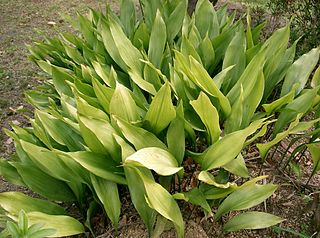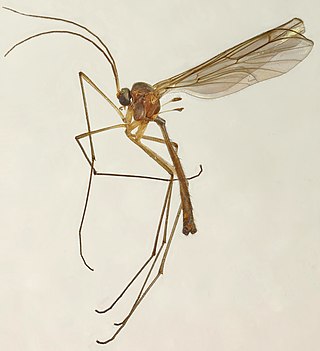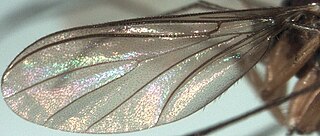
The Nematocera are a suborder of elongated flies with thin, segmented antennae and mostly aquatic larvae. This group is paraphyletic and contains all flies but species from suborder Brachycera, which includes more commonly known species such as the housefly or the common fruit fly. The equivalent clade to Nematocera is the whole Diptera, with Brachycera as a subclade. Families in Nematocera include mosquitoes, crane flies, gnats, black flies, and multiple families commonly known as midges. The Nematocera typically have fairly long, fine, finely-jointed antennae. In many species, such as most mosquitoes, the female antennae are more or less threadlike, but the males have spectacularly plumose antennae.

Fungus gnats are small, dark, short-lived gnats, of the families Sciaridae, Diadocidiidae, Ditomyiidae, Keroplatidae, Bolitophilidae, and Mycetophilidae ; they comprise six of the seven families placed in the superfamily Sciaroidea.

The Sciaridae are a family of flies, commonly known as dark-winged fungus gnats. Commonly found in moist environments, they are known to be a pest of mushroom farms and are commonly found in household plant pots. This is one of the least studied of the large Diptera families, probably due to the small size of these insects and the similarity among species.

Keroplatidae is a family of small flies known as fungus gnats. About 950 species are described, but the true number of species is undoubtedly much higher. The long-beaked fungus gnats, formerly placed in a separate family Lygistorrhinidae, have been placed into Keroplatidae as subfamily Lygistorrhininae. They are generally forest dwellers found in the damp habitats favoured by their host fungi. They can also often be found in caves. Larvae both feed on fungi and are predatory - they can spin webs by secreting acid fluids, which they use to kill smaller invertebrates and capture spores. Some of the predatory larvae cannibalize pupa of their own species. The family notably include the genus Arachnocampa; the larvae of which are known as "glowworms" in Australia and New Zealand.

Coenosia attenuata, commonly called "hunter fly" or well known under the name "killer fly", is a predatory fly belonging to the family Muscidae.

Sciaroidea is a superfamily in the infraorder Bibionomorpha. There are about 16 families and more than 15,000 described species in Sciaroidea. Most of its constituent families are various gnats.

Aspidistra elatior, the cast-iron-plant or bar-room plant, also known in Japanese as haran or baran (葉蘭) is a species of flowering plant in the family Asparagaceae, native to Japan and Taiwan. Tolerant of neglect, it is widely cultivated as a houseplant, but can also be grown outside in shade where temperatures remain above −5 °C (23 °F). It is used as training material for the seika form of ikebana.

The Ulodidae are a family of beetles belonging to Tenebrionoidea. They are native to the Southern Hemisphere, with species found in Australia, New Zealand, New Caledonia and Chile. Larvae and adults are generally found on dead wood or fungus associated with rotting wood, and are mycophagous. There are approximately 40 species in 16 genera.

Bolitophila is the sole living genus in the Bolitophilidae, a family of Diptera in the superfamily Sciaroidea, with around 40 Palaearctic and about 20 Nearctic species, and three species from the Oriental region (Taiwan). They are small (6–9 mm).
Docosia is a genus of fungus gnats in the family Mycetophilidae.

Dalotia coriaria, the greenhouse rove beetle, is a species of staphylinid rove beetle in the subfamily Aleocharinae. It is used as a predatory biological control agent for the management of pest insects.
Bradysia austera is a species of fungus gnat found in the British Isles.
Bradysia ismayi is a species of fungus gnat found in the British Isles.
Bradysia nigrispina is a species of fungus gnat found in the British Isles.

A gnat is any of many species of tiny flying insects in the dipterid suborder Nematocera, especially those in the families Mycetophilidae, Anisopodidae and Sciaridae. Most often they fly in large numbers, called clouds. "Gnat" is a loose descriptive category rather than a phylogenetic or other technical term, so there is no scientific consensus on what constitutes a gnat. Some entomologists consider only non-biting flies to be gnats. Certain universities and institutes also distinguish eye gnats: the Smithsonian Institution describes them as "non-biting flies, no bigger than a few grains of salt, ... attracted to fluids secreted by your eyes".

Bradysia ocellaris is a species of fly in the family Sciaridae. It is found in the Palearctic. It has also been introduced to Australia. It feeds on fungi, and larvae can feed on cultivated plants in greenhouses.

Lygistorrhininae, commonly called long-beaked fungus gnats is a subfamily of flies in the Diptera family Keroplatidae. The groups was long treated as a separate family, but molecular phylogenetic analysis has shown it to belong to Keroplatidae. There are about 7 genera and at least 30 described species in Lygistorrhininae.

Bradysia is a genus of fungus gnat in the family Sciaridae. They are commonly known as darkwinged fungus gnats. They are considered a major pest in greenhouse agriculture because they thrive in the moist conditions common inside greenhouses and feed on the plants being grown within. Bradysia is a large genus containing over 500 living species, with at least 65 species found in North America and 172 in Europe.

Rangomaramidae is a family of flies in the infraorder Bibionomorpha. The family, members of which are known as long-winged fungus gnats, was erected in 2002 by Jaschhof and Didham to include five new species of flies in the genus Rangomarama from New Zealand. The family was then expanded to include several other genera from across the world which were formerly classified as Sciaroidea incertae sedis, but preliminary studies show that the broad family is non-monophyletic.
Succinanthera baltica is an extinct, middle Eocene orchid known only from an anther cap with pollinarium attached to the base of the leg of a female fungus gnat, Bradysia, trapped in Baltic amber. It is the only species in the genus Succinanthera. The fossil was found in the Samland Peninsula and its age was determined by geochemical tests on the sediments surrounding the amber. The species is considered to be from 40 to 55 million years old.














